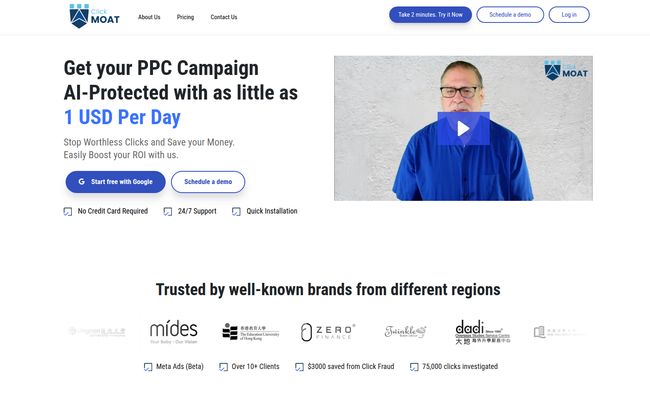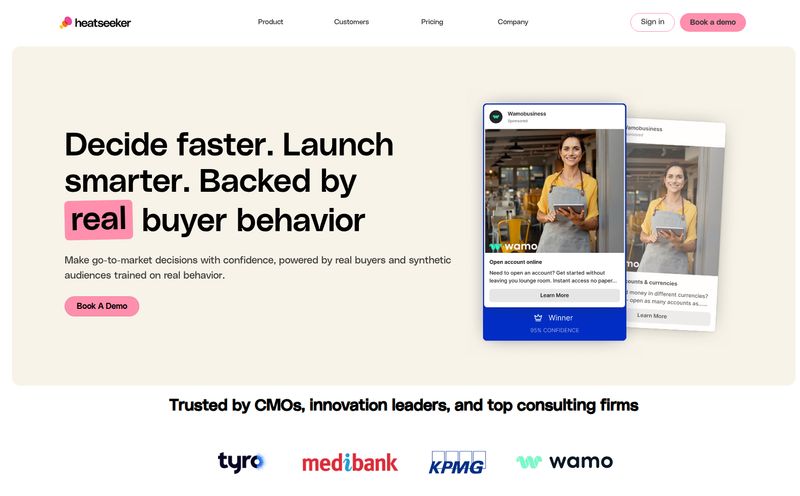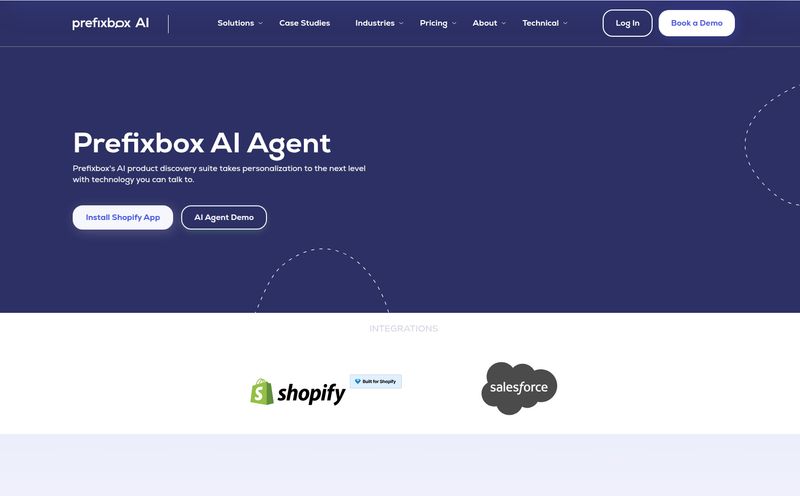I’ve been in the SEO and PPC game for what feels like a lifetime. I’ve seen trends come and go, watched Google change its mind more times than I can count, and I’ve managed ad budgets that would make your eyes water. And through it all, one thing has remained constant: the infuriating, soul-crushing problem of wasted ad spend. You know what I'm talking about. That sneaky little thief called click fraud.
It’s that nagging feeling you get when you look at your analytics. A spike in clicks, but no conversions. A bounce rate that’s through the roof. It’s the digital equivalent of someone walking into your store, knocking over a bunch of stuff, and then walking out without buying anything—except you're paying them for the privilege. For years, we’ve just sort of… accepted it. A cost of doing business on platforms like Google Ads. But what if we didn’t have to?
Recently, I got my hands on a tool called ClickMoat. The name itself is pretty evocative, right? A fortress for your clicks. It claims to use AI to automatically detect and block all that bogus traffic. I’m naturally skeptical of any new shiny object in the martech world, but I have to admit, I was intrigued. So I took it for a spin. Here's what I found.
The Silent Budget Killer Hiding in Your PPC Campaigns
Before we get into the tool itself, let’s get on the same page. Click fraud isn't just one thing. It’s a whole family of pests. You’ve got your classic competitor who sits there clicking your ads to drain your budget. You’ve got sophisticated bots and click farms designed to generate fraudulent impressions and clicks. And then you have just... weird, random traffic that has zero intent to ever buy from you. It all adds up.
Google has its own systems, sure. Their Invalid Clicks filter catches some of the obvious stuff. But let’s be real, Google’s primary goal is for you to spend money on their platform. Asking them to be the sole protector of your budget is a bit like asking the fox to design the security for the henhouse. It’s in their interest, but maybe not all of your interest. An independent shield, one whose only job is to protect your spend, just makes sense.

Visit ClickMoat
So, How Does ClickMoat Actually Stop the Bleeding?
This is the part that actually impressed me. The whole concept is built on being proactive, not reactive. Instead of just identifying bad clicks after the fact, ClickMoat aims to stop them from ever happening again. It's like having a bouncer at the door of your website who's really, really good at spotting trouble.
The process is refreshingly straightforward. Once you’re set up, ClickMoat’s AI starts analyzing every single click on your Google Ads. It looks at hundreds of data points—IP address, device, user behavior, location, and a bunch of other secret sauce ingredients. When it identifies a click as fraudulent, it doesn't just make a note of it. It automatically adds that shady IP address to your exclusion list in Google Ads. Instantly. That IP is then blocked from seeing and clicking on your ads again. It’s simple, elegant, and automated. No more spending your friday nights manually combing through IP lists. Thank goodness.
Getting Started is Surprisingly Painless
I’ve wrestled with enough clunky software interfaces to last a lifetime. I was bracing for a headache, but the ClickMoat setup was… easy. Like, 'why isn't all software this easy?' easy. You basically sign up, connect your Google Ads account, and add a small tracking snippet to your website. If you’ve ever installed a Google Analytics or Facebook Pixel, you can do this in your sleep. From there, the dashboard is clean and gives you all the info you need without a ton of clutter. You can see how much you’ve saved, where the junk traffic is coming from, and the specific IPs being blocked. It’s data you can actually use.
The AI Brains Behind the Operation
The core of ClickMoat is its detection algorithm. It’s not just blocking an IP that clicks too many times. It's smarter than that. It’s looking for patterns that signal non-human or malicious intent. This includes things like traffic coming from known data centers or VPNs, which are often used to mask a bot’s true location. It identifies click patterns that are too fast or too methodical for any real human. This AI-driven approach is what separates a modern tool like this from the more basic, rule-based systems of the past.
What's the Damage? A Look at ClickMoat Pricing
Alright, let's talk money. Because at the end of the day, any tool has to provide a positive ROI. The pricing structure here seems pretty fair and scalable, which I appreciate. And they have a 30-day free trial, so you can see if it's actually saving you money before you commit. A company that’s confident enough to do that usually has a solid product.
| Plan | Price | Key Features |
|---|---|---|
| Standard | $39 / month | Protects up to 5,000 Google Ad clicks, 1 Google Ads account, unlimited domains, and full reporting. Perfect for a small business or a solopreneur. |
| Pro | $69 / month | Bumps you up to 10,000 protected clicks and 2 Google Ads accounts. A good fit for a growing business or a small agency. |
| VIP | Custom Pricing | For the big players. More than 10k clicks, unlimited accounts, a dedicated manager... the works. This is for serious agencies and large enterprises. |
When you think about it, if the tool saves you even just a few hundred dollars in wasted clicks per month—which is not a high bar for many accounts—it easily pays for itself. It’s not an expense; it’s an investment in efficiency.
My Honest Take: The Good, The Bad, and The Meh
No tool is perfect. Let's get that out of the way. After playing around with ClickMoat, here's my brutally honest breakdown.
What I really liked was the sheer simplicity and effectiveness. The AI-powered detection is top-notch, the interface is clean, and the automated blocking is a massive time-saver. The 24/7 support is a nice touch, and for the price, it feels like a bargain. The peace of mind knowing that a vigilant AI is constantly guarding your budget is, frankly, priceless.
Now, for the other side of the coin. The biggest thing to be aware of is that its main focus right now is Google Ads. They have Meta Ads protection in Beta, which is promising, but if you’re looking for an all-in-one solution for every ad platform under the sun today, this might not be it just yet. Also, while it helps you identify fraud for potential refunds from Google, you may still have to go through the manual process of applying for that refund yourself. It gives you all the ammunition you need for the fight, but you might still have to pull the trigger.
Is ClickMoat the Right Shield for Your Campaign?
So, who is this for? In my opinion, if you're spending more than a few hundred dollars a month on Google Ads, you should seriously consider it. For a small business, protecting a $1,000/month budget from even 10-15% fraudulent clicks means the Standard plan pays for itself several times over.
For marketing agencies, it's a complete no-brainer. You can add a layer of protection and value for your clients, improve their campaign performance, and justify your management fee with cleaner data and better ROI. The Pro and VIP plans are clearly built with agencies in mind. It's a tool that makes you look smarter and makes your clients' money go further. That's a win-win.
If your budget is tiny or you're just dipping your toes into PPC, you might be able to get by for now. But once you start scaling, that leaky pipe of click fraud is only going to get bigger.
Frequently Asked Questions About ClickMoat
Is click fraud really that big of a deal?
Oh yeah. It’s a huge, shadowy corner of the internet. Some reports estimate that businesses lose billions of dollars to it every year. It’s not just a minor annoyance; it can seriously skew your data and drain your marketing budget before you even know what's happening.
Will I be charged after the 30-day free trial ends?
The site says you'll be notified before your trial ends, and you can cancel anytime. I appreciate that transparency. They seem to want you to stick around because you see the value, not because you forgot to cancel.
How hard is it to install on my website?
Super easy. It's a simple copy-and-paste job. If you use a common CMS like WordPress, there are plugins and guides that make it even simpler. It probably takes less than 5 minutes for someone with basic web knowledge.
Does ClickMoat block real potential customers?
This is always a concern with fraud protection. From what I’ve seen, the AI is pretty sophisticated. It’s not just blocking people based on a single action. It’s analyzing deep patterns to find genuinely malicious or non-human behavior. The risk of blocking a real customer seems very low, far lower than the risk of paying for a bot to visit your site.
Can this help me get a refund from Google?
Yes, it can definitely help. ClickMoat provides detailed reports on all the fraudulent activity it blocks. You can use this data as evidence when you apply to Google for a refund on invalid clicks. It strengthens your case significantly.
The Final Verdict on ClickMoat
Look, the world of PPC is a battlefield. You're fighting for attention, for clicks, and for conversions against a sea of competitors. The last thing you need is to be fighting invisible enemies like bots and click farms, too. Wasting money on fraudulent clicks is a problem that has plagued advertisers for years, and we've been told to just live with it.
I dont think we should. Tools like ClickMoat are changing the game. It’s an affordable, effective, and easy-to-use shield for your ad spend. It plugs a major leak in your marketing budget and frees you up to focus on what actually matters: creating great ads and connecting with real customers. Is it perfect? No, but its pretty darn close. For what it does, and for the price, it’s one of the smartest investments a Google advertiser can make.



